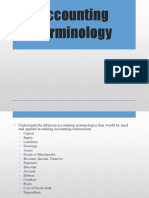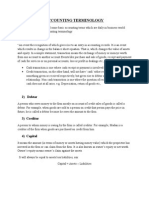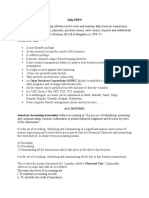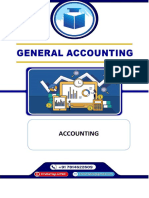0 ratings0% found this document useful (0 votes) 26 views8 pagesBasic Accounting (Basic Accounting Terminology)
Copyright
© © All Rights Reserved
We take content rights seriously. If you suspect this is your content,
claim it here.
Available Formats
Download as PDF or read online on Scribd
Basic Accounting Terms
RRA, i erence
Payment of rent, salary, purchase of g00ds, purchase of land, machi furniture
etc. are the sth cas td ‘eee Broadly speaking, bapa oe of three
namely (i) Capital expenditure (ii) Rev:
ops ee /enuie expenditure and (iii) Deferred
(i) Capital Expenditure
All those expenditures which are incurred by the organization for acquiring
fixed assets are called capital expenditure ¢, ‘8, purchase of computers, land,
building, machinery, furniture, etc. The Money spent on bringing these assets
like freight, carriage or money spent on installation of plant and machinery ie
also a capital expenditure. Similarly, amount spent for improving the existing
assets so as to enhance its operating capacity in future is also a capital expencliture
The benetit of these assets accrue to firm over a number of accounting, periods.
‘These assets are shown in the Balance Sheet on the assets side, These assets are
‘written off in the form of depreciation over the period of their use in the business.
(i Revenue Expenditure
All those expenditures which are incurred in the firm during an accounting
period and the benefit of which is also enjoyed by the firm in the same accounting
period, are termed as revenue expenditures ¢.g., purchase of goods and serviews,
payment of salary, rent, advertisement, etc.
All the revenue expenditures are debited to either Trading Account or in
Profit and Loss Account as per their nature. These expenditures do net enhance
the earning capacity of the business so they are never shown as asset in the
balance sheet. All revenue expenditures are also termed as expense.
Distinction between Capital Expenditure and Revenue Expenditure
ase cited > Crating A/s oe Prodi
Damen a0 pas thaie mature
incueved te the day te doy
eosin 0 the busine,
s benefit of a revenue expenditure is likely to accrue to firm over 4
os revenue expenditures are termed as deferred
‘amount of money spent on advertisement for
foals as advertisement igvelopment
‘Maruti Suzuki Ltd. Spent € 50 lakhs on
: i ew Prdel of car Maruti Desire and it hopes that it�eee
will yield benefit for 5 years to company. The 1/sth advertisement amounting
% 10 lakh will be debited to Profit and Loss A/c being revenue expenditure and
4/sth advertisement cost amounting % 40 lakh will be shown as asset in the
Balance Sheet being portion of deferred revenue expenditure. Similarly, € 10
lakh will be written off each year from the Balance Sheet and shown on the debit
side of Profit & Loss A/c.
9. EXPENSE
Expense is the cost incurred in producing goods and services for selling
purpose. Thus, expenses include:
(i) Cost of goods sold/cost of sales.
(ii) Amount paid for general business expenses such as salary, rent,
advertisement, stationery, etc.
(iii) Depreciation i.e., decrease in the value of fixed assets used for the purpose
of business is also an expense.
(iv) An amount written off out of Debtors towards bad debt or provision for
doubtful debt for current year is also an expense.
The cost of good sold is charged (debited) to Trading A/c while all other
expenses are debited to Profit & Loss A/c.
10. INCOME
Income is the amount of profit earned during an accounting period. Incomes
are different from revenues. Amount received from sale of goods and services is
called revenue. Similarly, cost of goods sold is called expense. Thus, surplus of
revenue over the expense is called as income. It is expressed as:
For example, goods costing ¥ 2,00,000 is sold for & 2,60,000. The sales price of
goods sold is a revenue while cost of goods sold is an expense so € 60,000 is an
income
Income = Revenue — Expense
= € 2,60,000 - & 2,00,000 = ¥ 60,000
11. PROFIT
‘The excess of revenue over total expenses (costs) of a business entity for an
accounting period is termed as profit. Profit may either be:
(i) Gross Profit or (ii) Net Profit.
(i) Gross Profit: The difference between sales revenue and the cost of goods
sold or services rendered is called as ‘Gross Profit’.
(ii) Net Profit: If all the operating expenses (such as administrative, selling
and financial) and other non-operating expenses are deducted from the
gross profit and other income, if any are added, it is called net profit. It
is finally added to capital of the owner. On the other hand, if total
ex] exceed revenue, it is a net loss and it is finally deducted from
the capital of the owner.�12. GAIN f
Gains are profit that arises from those trans:
_ A actions which are incidental to
business. For aon ple, profit earned on sale of investment or sale of fixed assets,
The profits in the nature of gain are of irregular or of non-recurring nature,
13, LOSS
Excess of expenses over revenue of a business entity for an accountiny lod
is termed as loss. The owner's Capital is reduced to the extent of pei i loss.
The term loss is also used in another context, It refers to such activities of
the business for which no benefit is received by the firm. For example, loss of
goods due to fire, accident or theft etc, It is pertinent to note that expenses are
different from losses. Expenses are incurred by the entity to generate revenue
(sales) while losses do not generate any revenue. For instance, bad debts, provision
for doubtful debts and depreciation are expense while goods lost by fire or theft
14, PURCHASES
The term ‘Purchases’ is used for the purchase of goods. Goods are the
products in which the firm is dealing or producing for sale purposes. In trading
M1 goods are purchased for resale while in manufacturing concerns, raw
are purchased and processed further into finished goods for resale
. For example, if a dealer of furniture purchases furniture for sale
,, it is a goods. However if same dealer purchases motor vehicle for
ery purposes, it is not purchase of goods rather it is purchase of an asset.
‘If the goods are purchased for cash, it is called ‘Cash Purchases’ but if it is
shased on credit, it is called as ‘Credit Purchases.’ Both Cash and credit
es are debited to Trading Account.
44(A). PURCHASES RETURN
Goods purchased from the supplier may be returned due to manufacturing
efects or due to difference in the specifications so such returned goods are
‘as Purchases Return or Returns Outward. Purchases return is deducted
purchases to find out the net purchases to be debited to Trading Account.
% 15, SALES
is used for sale of only those goods in which the firm is dealing ic.,
ght or produced or processed for resale purposes. The term sales is
for sale of asset, however, it includes revenue generated from services
(ustorners, Thus, a shopkeeper selling electronic iteris is a sale but if
furniture, it is not termed as sale. Similarly, an electricity company
, electricity to consumers in the area is a sale of service, “i
it is called whereas goods sold to customer
cases Aes paneer sales is shown on the
Trading, Account.
45(A)- SALES RETURN
1c vs is returned by the buyer, it i called as Sales
ea joce saqy.ne returned ttn puainanes de,�p Accountancy ~ XI
ee
variation in size, specifications, quality etc. Sales Return is deducted from the
sales to find out the net sales to be credited to Trading Account.
16. STOCK OR INVENTORY
The term stock refers to include the value of goods remaining unsold at the
end of the accounting year with the business entity. In case of trading concern, it
includes unsold goods at the end of accounting year while in case of a
manufacturing concern, it includes raw materials, work-in-progress (semi-
manufactured goods or partly manufactured goods) and finished goods.
The stock may also be of two types, namely:
(i) Opening Stock (ii) Closing Stock
(i) Opening Stock: It refers to the goods lying unsold at the beginning of
the accounting year.
(éi) Closing Stock: It is the amount of goods lying unsold with the business
entity at the end of the accounting year.
It should be noted that closing stock of this year becomes the opening stock
of the next accounting year. Stock is classified in the Balance Sheet under the
head, “Current Assets”. It is always valued at cost price or market price whichever
is less based on principle of prudence.
17. TRADE RECEIVABLES (DEBTORS AND BILLS RECEIVABLES)
‘The term Trade Receivables has been used in the revised schedule VI to the
‘Companies Act, 1956 and now in Companies Act, 2013 to represent both debtors
and bills receivables for the first time. Trade Receivables are those persons or
firms to whom either goods have been sold on credit/services rendered on
credit or they have agreed in writing to pay the specified amount at a future
date to the seller of goods/services. It would be better to know both debtors and
bills receivable separately.
18(A). DEBTORS
The person or firm to whom goods have been sold on credit or services
rendered on credit are called debtors. Till they make the complete amount due
towards them, they will be called debtors. For instance, goods sold to Ram
worth % 5,000 on credit. Ram is debtor of our firm till he clears the full amount.
‘The amount due towards Ram is debt so he is our debtor. Debtors are shown in
the balance sheet on the asset side under the head, “Current Assets”.
18(B). BILLS RECEIVABLE
A Bill of Exchange is written by the seller of goods on the buyer of goods
directing the later to pay the specified amount at a future date. A bill of exchange
becomes bill receivable for the seller of goods or services (drawer) after getting
‘the acceptance of the buyer of goods (drawee). Bill Receivables are shown on the
‘asset side of the Balance Sheet under the head, “Current Assets”.
49. TRADE PAYABLES (CREDITORS AND BILLS PAYABLES)
‘The term “Trade payables’ has been used for the first time in revised schedule
‘Vi to the Companies Act, 1956 and now in Companies Act, 2013 to represent
‘both creditors and bills payable. Trade payables are the persons or firms from
ee ae�|
|
}
Ww Acountaney ~
34. BOOK VALUE
This term is used with reference to fixed assets like plant and machinery,
furniture etc. At the end of the accounting period, fixed assets are shown at their
costs less depreciation. This is called book value of these assets.
35. DEPRECIATION
Depreciation refers to continuing and gradual decline in the value of fixed
assets. It is charged every year as an expense/loss in the value of fixed assets to
determine the cost of production of goods properly.
36. SOLVENT
‘A person or business entity who is in a position to pay its debts in full, is
called a solvent.
37. INSOLVENT
If a person or business entity is not in a position to Pay its debts in full, he/
it is said to be insolvent. In such cases, the liquidator appointed by court makes
(pro-rata) payment to all the unsecured creditors in full settlement of their
accounts.
EXERCISES
(A) Remembering Based Questions — marked
1, What are business transactions?
Ans. Business transactions refer to financial transactions entered into between
two parties involving exchange of goods or services for monetary
consideration e.g., purchase of goods, sale of goods, payment of salary,
rent; receipt of cash from debtors etc.
2. Give two examples of internal transactions.
Ans. (i) Charging depreciation on asset.
(ii) Creating provision for doubtful debt on debtors.
© 3. Whatis an account?
Ans. An account is a record of all business transactions pertaining to an
individual, firm or item in a chronological (datewise) order. e.g., account
of Ram, Mohan Lal & Co., salary, etc. These accounts are kept in ledger
of the firm,
4. Whatis meant by capital?
Ans. Amount invested by the proprietor or owners in the business in the
form of cash or assets is called capital.
5. Whatis drawing?
Ans. Drawing refers to cash or value of goods taken by the proprietor or
partners of the firm for their personal use. Thus, capital of the firm is,
reduced.�29. DEBIT AND CREDIT
Ledger contains complete record of all luring
accounts of the business entity d
mee an Ledger account has two parts, namely (i) Debit and wo Credit.
hand side of ledger is called debit side and the right hand side of ledger
talled credit side. Dr. stands for debit and Cr. stands for credit.
Ledger
Ram's Account
Drew cra te
30. LIVE STOCK
__ Animals like horse, ox, camel etc. are used in transporting goods from one
to another by attaching them in cart. Thus, living animals are termed as
tock in business transactions. They are shown under ‘Fixed Assets’ in
ince Sheet,
31. INVOICE OR BILL
Invoice or Bill is prepared by the seller of goods when he sells goods to
‘of goods on credit. It is prepared in duplicate. It contains detail like name
buyer, detail of goods sold, rate, quantity and amount of sales. Original
of bill is given to the buyer while office copy of invoice is retained by the
‘of goods as an evidence of sale for recording the transaction in the books
ac It is purchase bill from the point of view of buyer of the goods.
copy)
32, ALLOWANCE
reduction in sales price is given to a customer due to some minor
the product, it is called allowance, It is treated similar to discount
discount received.
33, BAD DEBTS
‘amount that has become irrecoverable from the debtor (to
ft sen atarciest) due to dispute or insolvency of the debtor.
$0 it is debited to Profit and Loss Account.�— ee
(i) Trade Discount ; 56
When a dealer of goods is allowed reduction in the price of goods at a fixed
percentage on the list price or catalogue price by the another dealer while making
sales, it is called as trade discount. The objective behind giving reduction in the
list price is that the ultimate consumer of the goods gets the product at the list
Price. It is generally offered by the manufactures of goods to wholesalers and
wholesalers to retailers. This reduction in the list price is deducted from the sale
Price directly so the entry is passed for the net amount of sales price, Hence, no
entry for trade discount is passed in the books of accounts.
(ii) Cash Discount
When the debtors are allowed some discount (reduction) in the amount due
to induce them to make prompt payment or to make payment within the specified
time, it is called as cash discount. It is always recorded in the books of accounts.
It is of two types, namely:
(a) Discount allowed (b) Discount received
(@) Discount allowed: If cash discount is allowed to debtors to induce
them to make prompt payment, it is called as discount allowed. It is «
loss so it is treated as an expense and debited to Profit & Loss Account.
(®) Discount received: If the cash discount is received by the creditors for
making prompt payment of goods bought, it is called discount received.
Being an income, it is credited to Profit and Loss Account.
ETT eace
Proprietor is considered distinct from the business entity so capital invested by
him is considered as internal liability of the business.
26. BOOKS OF ACCOUNTS -
The term books of accounts refer to journal and ledger of a business entity in
which all the financial transactions are recorded for an accounting period. In
is further sub-divided into various subsidiary books or books of original entries.
1. Cash Book 2. Purchases Book 3, Sales Book
4. Purchases Return book 5, Sales Return Book 6, Journal Proper
27. ENTITY
An entity in accounting language refers to an economic unit engaged in
performing economic activities like Maruti Suzuki, Dabur India, DLE ete.
28. ENTRY
The recording of each transaction in the books of accounts is called an entry,
i bvangeiiiensh.Wjlil..... .. rv�Basic Accounting Terms
20(A). CREDITORS
Creditors are persons or firms fro
‘ m_ whom we have purcha:
procured services on credit, Pence ae
4 They will continue to remain our creditor till we
clear their account by making the payment, For example, purchased goods from
X & Co. worth € 10,000. % 3,000 have been paid so far. X & Co. is still cur creditor
for © 7,000 as the amount is still due towards it. Creditors are shown on the
Nabilities side of Balance Sheet under the head, “Current Liabilities”.
20(B). BILLS PAYABLE
The buyer of goods or services who accepts the bill of exchange drawn by
seller of goods, becomes drawee of the bill. On the acceptance of the bill of
exchange, it becomes bills payable for the buyer (drawee) of goods or services.
Bills Payable are shown on the liabilities side of the Balance Sheet under the
head, “ Current Liabilities”.
21. GOODS
Goods is referred as the products in which the firm is dealing ie., it is
buying and selling the product or it is producing the product and selling it. The
items so purchased or produced are part of the Stock-in-Trade of the business
entity. Other items purchased for use in the business are not included in the
. For example, if a firm dealing in furniture buys chairs and tables is
ned as goods. But if a firm dealing in hardware items buys a table and chairs,
it will be considered as an asset under the head, furniture and not goods.
Similarly, stationery items are goods to a dealer of stationery but for a firm
in electrical appliances, it is an expense and not the goods.
22. COST
Cost is the amount of the expenditure incurred on or chargeable to a specified
23. VOUCHER
tetasieovsi wnt prepared by the accountant providing the
Be cies tassaction. The evidence of abuses sation
Sr i memo, purchase bill, sales bill, pay-in-slip,
ee pees ree Ie Pont are it epecifies the account tae
Manse ae te oie pasis of vouchers, transactions are recorded for the
Se erat credited. ON original entry i., in journal or in the subsidiary
Emme in the books oF os are passed on the basis of vouchers so they are
teeing v ae ‘and source document of each transaction is
Hee a cc hees All the vouchers are numbered and signed by its
vouchers.
24. DISCOUNT
: type 5 busines:
_Any ion ii rice of the goods by the busin
is ca Se Discount is of two types, namely:
(ii) Cash Discount
entity to its
a
;
i


























































